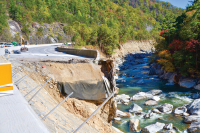Epp’s Springs were once Bryson City’s calling card
 A friend of mine who is a veteran backcountry explorer in the Smokies sent a recent email to me and others in which he noted that various lodges and hotels associated with the Great Smoky Mountains National Park “would make a good topic for a book … including such locations as the Wonderland in Elkmont, the original Cataloochee Ranch, the Swag, the ones at Tremont, below the Chimneys Picnic Area, and on the Tuckaseegee at Canebrake, as well as the one up on the Thomas Divide and the old Mountain View in Gatlinburg. I am sure there are many others but those are just the ones I can think of.”
A friend of mine who is a veteran backcountry explorer in the Smokies sent a recent email to me and others in which he noted that various lodges and hotels associated with the Great Smoky Mountains National Park “would make a good topic for a book … including such locations as the Wonderland in Elkmont, the original Cataloochee Ranch, the Swag, the ones at Tremont, below the Chimneys Picnic Area, and on the Tuckaseegee at Canebrake, as well as the one up on the Thomas Divide and the old Mountain View in Gatlinburg. I am sure there are many others but those are just the ones I can think of.”
His mention of a lodge “on the Tuckaseegee at Canebrake” caught my eye because my house is situated (on Lower Lands Creek) about 1.5 miles east of Canebrake Creek. The establishment is usually referred to as Epp’s Springs or the Epp’s Springs Hotel in contemporary documents. But the spelling varies from Epps Spring to Epps Springs to Epp’s Spring and so on.
Its claims to fame were advertised in the Asheville Citizen (July 7, 1907) as “unsurpassed” climate and scenery; “excellent bass fishing;” and “medicinal waters [that] are splendid for stomach and kidney diseases [containing] nine medicinal ingredients found by Joseph Hyde Pratt, State Geologist, and strongly recommended by him. / Rates $1.00 and $1.50 per day.”
In his report The Mining Industry in North Carolina During 1907 with Special Report on the Mineral Waters (1908), Pratt described Epp’s Springs: “This spring is located at the foot of East Canebrake Knob, about 5 miles west of Bryson City and 150 yards up Canebrake Branch from Epps Springs, a station on the Murphy branch of the Southern Railway. There is a small hotel, containing 12 rooms, that has been built for the accommodation of guests, which is within 50 yards of this spring, and has running water. There are 500 acres of ground belonging to the spring property, which is largely covered with timber, as oak, popular, chestnut and some pine. Although there have been but little improvements made on this property, it offers a favorable location for building up a mineral spring resort … Canebrake Branch offers sufficient power to develop electricity for lighting the hotel ... The water from Epps Spring gushes out from the rock on the west side of a steep hill and is within 30 feet of Canebrake Branch, but well above it .…”
The spring and facility were named for Epaphroditus Everett, one of Bryson City’s leading citizens. There is a lengthy account of “Epp” Everett’s life by Helen Ann Leatherwood Cody in The Heritage of Swain County (1988) that incorporates an anonymous “Biographical Sketch” which appeared in The Appalachian (an early newspaper) in 1903, the year of Everett’s death.
Epp was born in McMinn County, Tennessee, in 1830; prospected for gold in California; served as Captain of Company E of the 3rd Tennessee Infantry (seeing action at First Bull Run); and came to WNC in 1867, where he eventually became Swain County’s first sheriff and first mayor; and “amassed a moderate fortune” by “buying up land cheap and selling the timber rights.” His son, John H. Everett, who was born in 1856, took over the operation of the Epp’s Springs facility following his father’s death.
Related Items
A “History of Epp’s Springs” was included in a front page article about Swain County that appeared in the Raleigh News and Observer (July 21, 1907): “About eighteen years ago, a syndicate was formed by the following persons: Col. A.B. Andrews, Col. Theodore Pool, Maj. Wilson, Gov. Robinson, Robert Furman and E. Everett in Swain County to buy up timber, mineral, and farming lands. E. Everett was secretary and. treasurer. They bought lands in Macon, Graham and Swain counties … comprising several thousand acres … After E. Everett died, his son, J.H. Everett exchanged his father’s sixth interest in all the other lands for the Epp’s Springs tract. This property has on it a very valuable mineral spring which was analyzed by A.S. Wheeler, through Joseph Hyde Pratt, State Geologist.”
Wheeler’s analysis (based on parts per million) cited various chlorides, sulphates, bicarbonates, oxides, and silicas that had, supposedly, stimulated “some wonderful cures” through the years.
The article then went on to elaborate upon plans for “a modern hotel to be erected in the near future at the railway station, two hundred yards from the spring [with] water to be pumped into the lobby.” There were to be electric lights in the hotel powered by Canebrake Branch.
But by the time John P. Arthur published his Western North Carolina: A History in 1913, the chapter he devoted to Notable Resorts and Improvements barely mentioned Epp’s Springs in passing as “the property of the late Epp Everett of Bryson City” where “there are two cabins.”
It’s has been some time since I visited the mouth of Canebrake Creek (by walking down the Tuckaseigee River in winter when the Fontana Lake is down) but I can’t recall ever observing remnants of a rail depot or a mineral springs resort. Time flies and things pass away.
(George Ellison is a naturalist and writer. He can be reached at This email address is being protected from spambots. You need JavaScript enabled to view it..)









